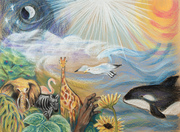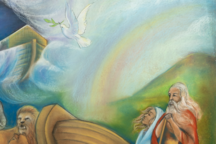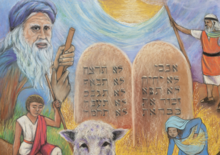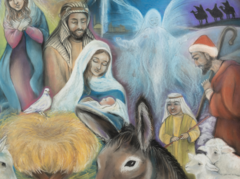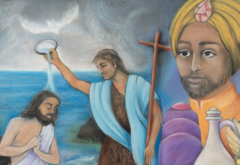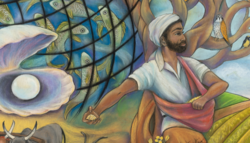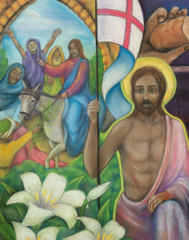Pastels Liturgical Murals
Continuous Narratives
The following images are from murals that can be found at https://fineartamerica.com/profiles/marlene-chapin.They were developed for teaching visual literacy to children learning bible stories from the liturgical calendar. Early Christians could not read so the biblical stories were told through a continuous narrative that illustrated the scriptural text. Even young children can find something they recognize in the images and can tell the stories from their experiences and viewpoint. Creation is the first full view mural followed by partial clips from a section of the remaining eight murals.
The full view of Creation above begins the liturgical calendar. God separates the heavens from land and sea, light from darkness, and brings forth plants, animals, birds of the air, sea creatures, and humankind to care for creation.
The Flood
God's promise to save the faithful family of Noah along with animals to survive the flood. The rainbow and the dove returning with an olive leaf is God's promise to replenish the earth.
Exodus and Promised Land
Moses (upper right) meets God in a burning bush and leads Israel out of Egypt through the Red Sea, giving us the ten commandments. Samuel (upper left) was the prophet who selected judges and kings to represent Israel in their new Promised Land. The shepherd Daniel from the tribe of Judah, became King and is the family ancestor of Jesus. The two women represented are Ruth, picking wheat leftover in the fields, and Queen Esther. Ruth married into the tribe of Judah and returned there with her mother-in-law to care for her. She is the ancestor of Mary and Joseph from the House of David. Queen Esther protects the dispersed Jewish community from the Persian empire who tried to silence their belief in only one God. All stories of the Old Testament provide the historical lineage of Christianity.
Birth of Christ
The Annunciation (upper left) announcement from Angel Gabriel to Mary begins the life of Christ. The attending peacock, an early Christian symbol as the Bird of Paradise, expresses God's desire to bring humanity back into a divine union. Mary and Joseph return to Bethlehem (meaning "House of Bread") known as the city of David, another tie to the tribe of Judah, for the Roman census. The birth of Jesus occurs in a humble stable manger, surrounded by animals and shepherds who were told of his birth by angels. They are awaiting the arrival of the Wise Men from afar, following a star.
Baptism of Christ
After the Visit of the Magi during Epiphany, Mary and Joseph are warned in a dream to go to Egypt. King Herod does not want to be replaced by a new King as prophesied in scripture. They are again told in a dream to return to Israel and settle in Nazareth, district of Galilee. Jesus grows in wisdom and begins his ministry with baptism by his cousin, John. The seashell John uses is an early Christian symbol of baptism representing cleansing, newness. God affirms John's belief that Jesus was the Messiah by descending a dove and speaking "This is my beloved son in whom I am well-pleased."
Ministry and Miracles
During Jesus' ministry he performs many miracles of healing and mercy. The wine jars (lower left) are from one of his first miracles, changing water into wine at the Wedding of Cana. He heals the leper, an outcast from society and a woman with a bleeding disease. Jesus calms the storm (upper right) for his apostles and feeds thousands of people. The mosaic image of the loaves and fishes is an early Christian symbol found in the catacombs outside Rome. During persecutions, Christians were safe outside the city and may have hidden in the catacombs for protection. The golden dome in the background is the Dome of the Rock in Jerusalem where Jews and Christians believe the world was created as well as the place Abraham was asked to sacrifice Isaac who was saved by angels. It may also be the original site of Solomon's Jewish temple. Muslims believe Mohammed ascended to heaven from the site on a white donkey during his Night Journey.
Parables of the Kingdom
Jesus taught in parables about the Kingdom of God beginning with the crown, a symbol for God's reign on Earth. Out of the crown comes the flower of the mustard seed, a parable about how even the smallest seed of faith can produce the tallest tree where the birds will flock. Wheat symbolizes fertility, bounty, and resurrection. Hands are wedging yeast into the dough to enlarge the bread, an example of leaven producing blessings. The Sower is throwing seeds everywhere which represents God's message of hope in the world. The seed can fall on a path where birds eat it, or rocks that prevent deeper roots so the plants perish under the hot sun, or thorn bushes/weeds that choked the growing seed, or good soil that produces corn to sustain all the possibilities of the Kingdom. The fish in a net is the parable of God offering the Kingdom to all, as the net is cast into the world. The pearl in a clam shell represents the exquisite value and beauty of the Kingdom. Our relationship with God is like the hidden pearl the merchant found and sold all he had to buy it. In early Christian art, it represents Christ as the Messiah, the pearl of great price. The last parable represented is the farmer who discovers treasure in a field, hides it again and sells all he has to buy the property.
Passion and Resurrection
Passion Week begins with Christ's triumphal entry to Jerusalem on a donkey. Jesus shares the Passover dinner with his disciples where he breaks bread and washes their feet. He wanted them to see that God was going to humble and sacrifice himself because only God could absorb the sins of the world. The Garden of Gethsemane is where Jesus stayed to pray on the night of his arrest and the Pieta depicts Mary holding her son after his death on the cross. In the distance is the empty cross behind the resurrected Christ. Easter lilies bloom symbolize purity, rebirth, new beginnings, and hope. The halo behind the head of Jesus is an early image of the uncreated light, God's grace illuminating the world through Christ, saints, and angels. The white flag with a red cross depicts the Lamb of God and Jesus' victory over death.
Acts of the Apostles
The Holy Spirit descends as tongues of fire anointing the disciples who go into the world sharing the good news of the gospel. They perform healing miracles causing the lame to walk. The stone refers to the portrait St. Stephen, a Christian martyr stoned to death. St. Paul oversaw persecuting early Christians, including the death of Stephen. God blinded Paul as he rode his horse, falling to the ground. Paul's sight returns when he repents and follows Christ becoming a missionary to the Gentiles. St. Philip, a disciple, baptizes the eunuch who brings the gospel to the Ethiopian church. St. Peter, another disciple, is imprisoned and freed miraculously spreading the truth of Christ throughout Palestine and Asia Minor. The book under the stone represents the four gospels written during the early Christian period. The four writers Matthew (man with wings), Mark (lion), Luke (ox), and John (eagle) comprise the life and teachings of Christ which helped to spread the good news of the gospel to the known world.
